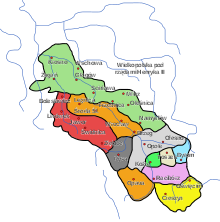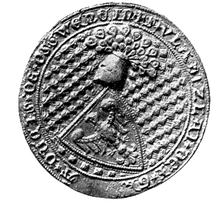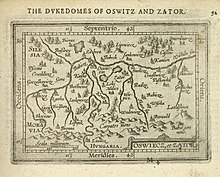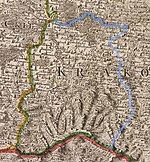Duchy of Auschwitz
The Duchy of Auschwitz (Polish Księstwo Oświęcimskie ; Czech Osvětimské knížectví ) was established around 1315 as a result of the division of the Duchy of Teschen . It was ruled by the Silesian Piasts , who sold it to the Polish king in 1457. In 1564 it became part of the Kingdom of Poland . The place of residence was the city of Auschwitz .
history

The area of Auschwitz belonged to a "no man's land" in the tribal period, which separated the Wislanen in the east from the Opolans and the Golensizen in the west and was only settled in the 11th and 12th centuries as part of Lesser Poland in connection with the road from Krakow through Teschen to Moravia . Together with other neighboring areas, it was transferred in 1177 or 1179 by the then senior Casimir II “the just” to the Ratibor duke Mieszko I “sacrum” , who incorporated it into his Duchy of Ratibor and in 1202 with this together with the Duchy of Opole . The handover indicates that the area was of minor importance at the time, but in the future it became a dangerous threat in the area around Kraków in international politics. In 1274, the eastern border of the duchy was moved from the Skawa River over 20 kilometers east to the Skawinka River in the east, just a dozen kilometers from Krakow.
In its division in 1281 reached Auschwitz to the Duchy of Cieszyn , the first Duke Mesko I was. The ecclesiastical affiliation of the area east of the Bialka and the Vistula as well as the complicated border near Kraków (the Radwanite Corridor and the exclave around Krzęcin ) made the consolidation of the eastern area of the Upper Silesian dukes difficult and may have prompted them to seek protection from the Bohemian king. Mieszko turned politically to Bohemia and on January 17, 1291, together with his younger brother Bolko I, concluded an alliance in Olomouc, King Wenceslaus II . The alliance was of particular importance for King Wenceslaus, who at that time was claiming the Cracow throne and who was already using the title of Duke of Cracow in the early 1291 , as the direct connection to Cracow led through its territory, which was conquered at Wenceslas Aspirations to the Polish throne was important.
Towards the end of the 13th century there was a large settlement under German law by Mesko I. At that time, several German language islands emerged in the Duchy of Teschen-Auschwitz , of which the Bielitz-Biała language island along the Biała River remained until after the 17th century.
After Mesko's death in 1315, the area of Auschwitz was separated from his second-born son, Wladislaus († 1321/24), and made an independent duchy. The new duchy had an area of 2,473 km², including a small exclave of around 60 km² in the east, which was separated by the Radwanite Corridor. Wladislaus' son John I entered into a vassal relationship with the Bohemian King John of Luxembourg in 1327 . The accompanying document mentioned two cities with full rights, Auschwitz ( Osswencin ) and Zator ( Zathor ), and four oppida Kęty ( Kant , later Liebenwerde ), Żywiec ( Zipscha , later Saybusch ), Wadowice ( Wadowicz , later Frauenstadt ) and Spytkowice (Spitkowicz) . As a fiefdom of the crown of Bohemia , the duchy was subordinated to the Holy Roman Empire of the German Nation together with the other duchies in Silesia in 1348 . The 15th century was very turbulent because of the Hussite Wars . The activity of the robber barons increased and caused a rural exodus . According to Józef Putek, the inhabitants of German descent, especially the knighthood, the clergy and the urban patriciate, were expelled or even murdered.
In the years 1405 or 1407 to 1415 the Duchy of Auschwitz was reunited with the Duchy of Teschen: after the direct Auschwitz line with the death of Duke Johann III. Was extinguished in 1405, Przemislaus inherited Auschwitz, who was a son of the Teschen Duke Przemislaus I of the same name . The Duchy of Auschwitz fell to him after the death of his son just a year later. In 1407 King Wenceslas IV confirmed the assignment of the Duchy of Auschwitz to the Duke of Teschen, which was the last documented evidence of the actual Bohemian fiefdom. After Przemislaus' death in 1410 it fell to his grandson Casimir , a son of Przemislaus I of Auschwitz. Since Kasimir was not yet of legal age, he was under the tutelage of his uncle Bolko I until 1414. After Kasimir's death in 1434, the eldest son Wenceslaus administered the inherited area for his younger brothers Primislaus / Przemko III. and Johann IV. († 1495/97). During the Hussite Wars , the Auschwitz Piasts practically led an independent policy without regard to the Bohemian sovereign.
Division and sale to the Polish king
At the end of the Hussite Wars, the greatest destruction fell on the Polish-Silesian border area and the activity of the robber barons became a burden in the Polish-Silesian border area . This could have caused rural exodus. After the death of Sigismund von Luxemburg the pressure of Poland increased on the Duchy of Auschwitz, whose importance increased because of the conflict between Albrecht von Habsburg and Casimir the Jagiellonians . In 1438 Dzierżysław (Dzierżko) von Rytwian besieged Auschwitz and conquered Zator, probably in an anti-Habsburg diversionary campaign. In exchange for the omission of the occupation of Zator, Wenceslaus I of Auschwitz-Zator had to cede the Barwałd castle on the Żar hill, across from Lanckorona , to Mikołaj Serafin, which on February 3, 1441 by Wladislaus III. has been confirmed by Poland and Hungary . As a result, some villages of the Starostei of Barwałd were detached from the Duchy of Auschwitz and attached to Poland ( in perpetuum concedit ).
On January 19, 1445 a division took place, whereby the area of Zator (673 km²) was spun off for Wenzel and Primislaus / Przemko received the Duchy of Tost and the Weichbild of Saybusch :
"That the request of the teylunge belong to a right wing, namely Oswanczimischer and Zatorscher request, sunder Zeywescher request."
The new frontier was designated this way:
“And the grenitcz of the so-called gebittis sal raise to Roczin to ken Bulowitcz and ken Neydecke , which in front of them ken Glambowitcz to newen Flosnitcz to the Windissche Flosnitcz and to Monowiczer top grenitcz, with the exception of the pieces of the guttere, those in the brive des Satorischen please be shredded. "
The duchy of Auschwitz, which had been reduced in size, was given to the youngest brother, Johann IV. He later became a robber baron himself. In 1450, the Polish king Casimir IV Jagiełło decided for military intervention. In the following years the castle in Malec was besieged and taken, followed by the city of Auschwitz. In 1454 John IV was forced to take a feudal oath on the Polish King Casimir IV Jagiełło, which accelerated the takeover of the Auschwitz area (as well as Żywiec and Zator, closer to Kraków, but later taken over) by Poland.
With the sale to King Casimir IV Jagiełło three years later, the Duchy of Auschwitz was spun off from the Crown of Bohemia and ruled by Jagiellonians . The deed mentioned: two towns (Oświęcim and Kęty), two castles (in Oświęcim and Wołek), forty-five villages. Oświęcim and Zator were administered as royal estates as Starosteien . The royal areas of Lipnik and Barwald were mortgaged to private families as tenuta . Some private latifundia arose in the area , including the Saybusch , Sucha and the Myszkowski family.
In 1462 in Glogau , the Bohemian King Georg von Podiebrad († 1471) waived his claim to Oswęcim / Oswenczym, Wołek / Wolek, Szewer / Dewoz, Zator / Zathor, Berwald, Szywecz / Zilbez for life. In 1474, Vladislav II Jagiełło of Bohemia and Hungary renounced the claim to the whole area forever ( in perpetuum ).
In 1534, the Polish noble families in the Sejm postulated the annexation of the duchies of Auschwitz and Zator. Subsequently, the connection became an important political issue in Poland.
In Poland and Galicia
In 1564 the area of the Duchies of Auschwitz and Zator, united as the District of Silesia in the Krakow Voivodeship , was annexed to the Kingdom of Poland. As a result, the area lost its state independence, although the title of the Polish king and some legal peculiarities remained in the period of the Polish-Lithuanian aristocratic republic , e. B. Polish became the official language there instead of Czech, while Latin was still used as such in the rest of Poland. The Silesia region became an important center of the Polish Reformation at the turn of the 16th and 17th centuries . The Swedish Flood devastated the area and turned the Roman Catholic majority strongly against the Protestants. In the second half of the 17th and the first of the 18th centuries, separatist tendencies were shown by local sexes.
In the late 18th century, around 165,000 people lived in the Silesia region. In 1768 the Bar Confederation ("the first Polish national uprising") began in the area of the district . The local noble families were led by Maciej Bobrowski (from 1769 Antoni Wilkowski), Jan de Biberstein Starowiejski and Kazimierz Lgocki. In 1769 the leadership of the rebels met in Biala to discuss the planned procedure. However, the Confederation Army lost in the Battle of Lanckorona on May 23, 1771. The area was occupied by Alexander Vasilyevich Suvorov's Russian and Cossack troops until April 1772 .

In the course of the First Partition of Poland , the area was militarily occupied in May and June 1772 by the Habsburgs under the leadership of Richard d'Alton without resistance from the defeated noble family. Although the area represented less than 3% of the Kingdom of Galicia and Lodomeria , it became the strategic entrance to the Crown Land. At that time u. a. Joseph II. (1773 and 1779), the governors Pergen , Hadik , Auersperg , Brigido , the Bishop Ziegler , as well as German-speaking colonists in Galicia. In order to register her claims on the former Bohemian duchy, Archduchess Maria Theresa dubbed herself in her capacity as Queen of Bohemia, among other things, as "Duchess of Auschwitz-Zator". A year later, the Silesia District was dissolved and instead the Wieliczka District ( cyrkuł wielicki in Polish ) was established. This included the districts of Biala, Saybusch and Myślenice. In 1775, the number of district districts was greatly reduced and the area was now part of the Zator district. The new administrative reform in 1782 made the whole area subject to the Myslenice District , whose seat was moved to the city of Wadowice in 1819, which thus acquired the greatest administrative importance of the duchy for decades.
In 1807 the largest cities in the Duchy of Auschwitz-Zator were: Biala (4196), Kęty (3056), Andrychów (2663), Żywiec (2624) and Wadowice (1575), while Auschwitz only had 1575 and Zator 1397 inhabitants.
The duchy of Auschwitz-Zator, which was temporarily spun off from Galicia and assigned to Austrian Silesia from 1818 or 1820–1850, was a formal member of the German Confederation at the time , although before 1772 it had been subject to Poland and not the Holy Roman Empire . This apparently ill-considered decision did not bring about any practical changes with regard to the administrative suzerainty of the Galician gubernium in Lemberg, but it strengthened political and cultural influences from the German-speaking area and the society of the Bielitz-Bialaer Sprachinsel resisted the lifting of this formal assignment to Austrian Silesia in the German Confederation.
In 1867 communities of several judicial districts were combined to form administrative districts. The area of the former duchies Auschwitz-Zator was divided between the political districts of Biala , Wadowice and Saybusch .
After the First World War, the area fell to the Second Polish Republic in 1918 .
Dukes of Auschwitz
- 1315–1321 / 22 Wladislaus † 1321/22, son of Meskos I of Teschen
- 1321 / 22–1370 / 72 Johann I , † 1370/72, son of Wladislaus
- 1370 / 72–1376 Johann II. , † 1476, son of Johann I.
- 1376-1405 John III. , † 1405 ( end of the direct line Auschwitz )
- 1405–1406 Primislaus I of Auschwitz , † 1406, son of Primislaus I of Teschen
- 1407–1410 Primislaus I von Teschen † 1410, father of the above
- 1410–1414 Bolko I , † 1414, son of Primislaus I of Teschen
- 1414–1433 Casimir , † 1433, Duke of Auschwitz, Tost and ( half ) Gleiwitz , son of Primislaus I of Auschwitz
- 1433–1445 Wenceslas I , † 1465, 1445–1465 Duke of Zator; Son of Kasimir
- 1445–1457 Johann IV. , † 1495/97, son of Kasimir ( sold the Duchy of Auschwitz to Poland in 1457 )
- 1457–1772 personal union with the King of Poland
- 1772 / 1818–1918 personal union with the Archduke of Austria
literature
- Hugo Weczerka (Hrsg.): Handbook of the historical places . Volume: Silesia (= Kröner's pocket edition . Volume 316). Kröner, Stuttgart 1977, ISBN 3-520-31601-3 , family table on p. 598.
- Rudolf Žáček: Dějiny Slezska v datech . Praha 2004, ISBN 80-7277-172-8 , pp. 441 and 463.
- Paweł Mostowik: Z dziejów Księstwa Oświęcimskiego i Zatorskiego XII-XVI w . Toruń 2005, ISBN 83-7441-175-9 (Polish).
- Krzysztof Rafał Prokop: Księstwa oświęcimskie i zatorskie wobec Korony Polskiej w latach 1438-1513. Dzieje polityczne . PAU , Kraków 2002, ISBN 83-8885731-2 (Polish).
- Andrzej Nowakowski: Integracja księstwa oświęcimskiego z Królestwem Polskim (1454-1564) i późniejsze losy ziemi oświęcimskiej w kontekście Wadowic [Integration of Oświęcimskiego z Królestwem Polskim (1454-1564) principality according to its recent timescim (Auschwitz) 1454] principality with Polish (= Wadoviana: przegląd historyczno-kulturalny ). 2018, ISSN 1505-0181 , p. 166–207 (Polish, online [PDF]).
- Przemysław Stanko: Monografia Gminy Wilkowice . Wydawnictwo Prasa Beskidzka, Wilkowice 2014, ISBN 978-83-940833-0-4 (Polish).
Web links
Remarks
- ↑ Krzęcin, Pozowice , Facimiech , Zelczyna , Borek Szlachecki , Rzozów , Gołuchowice , Jurczyce , Polanka Hallera , Leńcze Dolne (Podolany) and Górne , as well as parts of the villages Radziszów and Wola Radziszowska
- ↑ The Latin name civitates refers here to the cities laid out according to Neumarkt law .
- ↑ The Latin name oppidum was used implicitly for small town-like settlements with market rights , which, however, did not have city rights. The settlements often emerged spontaneously around an oval market square with irregular buildings and functioned according to traditional, unwritten, ducal or Polish law . The exception was Kęty, which was created in 1277 according to the iure lembergensi ( Löwenberg law).
- ↑ Stronie , Leśnica , Zakrzów , Barwałd , Jaroszowice , the Ochodza forest , possibly also Chocznia
- ↑ The Saybuscher Weichbild with more than a dozen villages was probably pledged around 1447 or 1448, which started private rule in this area, which resulted in the separation from the duchy.
- ↑ Bielany , Łęki , Babice , Lipnik , Osiek , Brzeszcze , Monowice , Dwory , Stara Polanka , Nowa Polanka , Włosienica , Poręba , Grojec , Sparowicze (lost village on the left bank of the Soła), Nidek , Witkowice , Głębowice , Bulowice , Czaniec , Malec, Kańczuga , Nova Wieś , Roczyny , Broszkowice , Brzezinka , Rajsko , Franciszowice (Pławy) , Przecieszyn , Skidzin , Wilczkowice , Wilamowice , Hecznarowice , Bujaków , Kozy , Mikuszowice , Pisarzowice , Hałcnów , Biertołtowice , Komorowice , Żebracz , Bestwina , Dankowice , Stara Wieś , Jawiszowice , Harmęże
- ↑ with the town of Kęty and some villages along the Soła
- ↑ The Zator Starostei was established after the death of the last duke in 1513. In 1564 it included the towns of Zator and Wadowice and eight villages: Piotrowice, Wiglowice, Trzebieńczyce, Laskowa, Barwałd Średni, Rzyki, Ponikiew and Koziniec. By 1765 it expanded by: Monowice, Dwory, Brzezinka, Brzeszcze, Bielany, Kobiernice, Porąbka, Międzybrodzie, Bujaków and the city of Kęty. After 1772 it was nationalized by the Habsburgs.
- ↑ Duchy of Auschwitz-Zator made up around 3/4 of the Wadowice district.
Individual evidence
- ^ Jerzy Rajman: Pogranicze śląsko-małopolskie w średniowieczu [Silesian-Lesser Poland border region in the Middle Ages] . Wydawnictwo Naukowe Wyższej Szkoły Pedagogicznej, 1998, ISBN 83-8751333-4 , ISSN 0239-6025 , p. 26–39, 51–52 (Polish, online [PDF]).
- ^ Paweł Mostowik: Z dziejów Księstwa Oświęcimskiego i Zatorskiego XII-XVI w . Toruń 2005, ISBN 83-7441-175-9 , Aneks. Miejscowości ziemi oświęcimsko-zatorskiej, p. 60 (Polish).
- ^ Paweł Mostowik: Z dziejów Księstwa Oświęcimskiego i Zatorskiego XII-XVI w . Toruń 2005, ISBN 83-7441-175-9 , Aneks. Miejscowości ziemi oświęcimsko-zatorskiej, p. 72 (Polish).
- ^ Löwenberg law
- ^ Colmar Grünhagen , Konrad Wutke :: Codex diplomaticus Silesiae Volume 22 Regesta on Silesian history 1327-1333 . E. Wohlfarth's Buchhandlung, Breslau 1903, p. 7 [4620] (Latin, online ).
- ^ Krzysztof Rafał Prokop: Księstwa oświęcimskie i zatorskie wobec Korony Polskiej w latach 1438-1513 . Dzieje polityczne . PAU , Kraków 2002, ISBN 83-8885731-2 , p. 80-81 (Polish).
- ↑ Józef Putek: O zbójnickich zamkach, heretyckich zborach, i oświęcimskiej Jerozolimie: szkice z dziejów pogranicza Śląsko-Polskiego . Drukarnia Przemysłowa, 1938, p. 44-47 .
- ↑ A. Nowakowski, 2018, p. 171.
- ^ KR Prokop, 2002, pp. 80–81
- ^ KR Prokop, 2002, p. 47.
- ^ KR Prokop, 2002, p. 69.
- ↑ A. Nowakowski, 2018, p. 171.
- ^ Przemysław Stanko: Monografia Gminy Wilkowice . Wydawnictwo Prasa Beskidzkia, Wilkowice 2014, ISBN 978-83-940833-0-4 , p. 67-68 (Polish).
- ↑ Krzysztof R. Prokop, 2002, p. 151
- ^ KR Prokop, 2002, p. 203.
- ^ KR Prokop, 2002, p. 205.
- ↑ P. Stanko, 2014, p. 88.
- ↑ P. Stanko, 2014, p. 89.
- ↑ A. Nowakowski, 2018, p. 192.
- ↑ January Nepomucen Gątkowski: Rys dziejów księstwa oświęcimskiego i zatorskiego . Lwów 1867 (Polish).
- ^ Konrad Meus: Wadowice 1772-1914. Study przypadku miasta galicyjskiego [A study of a Galician town] . Księgarnia Akademicka, Kraków 2013, ISBN 978-83-7638-345-3 , p. 33 (Polish).
- ↑ K. Meus, Wadowice ..., p. 43.
- ↑ Most historians cite April 6, 1818 as the beginning of membership, when the German Confederation recognized the border shift. Nowakowski emphasizes, however, that the actual, legally binding imperial patent was not issued until March 2, 1820. A patent dated October 29, 1850 rejoined Galicia outside the German Confederation. Andrzej Nowakowski: Terytoria oświęcimsko-zatorskie w Związku Niemieckim: zarys prawno-historyczny . In: Przegląd Historyczny . 1985, ISSN 0033-2186 , p. 787. Tom 76, Numer 4.
- ↑ K. Meus, Wadowice ..., pp. 48-49.





